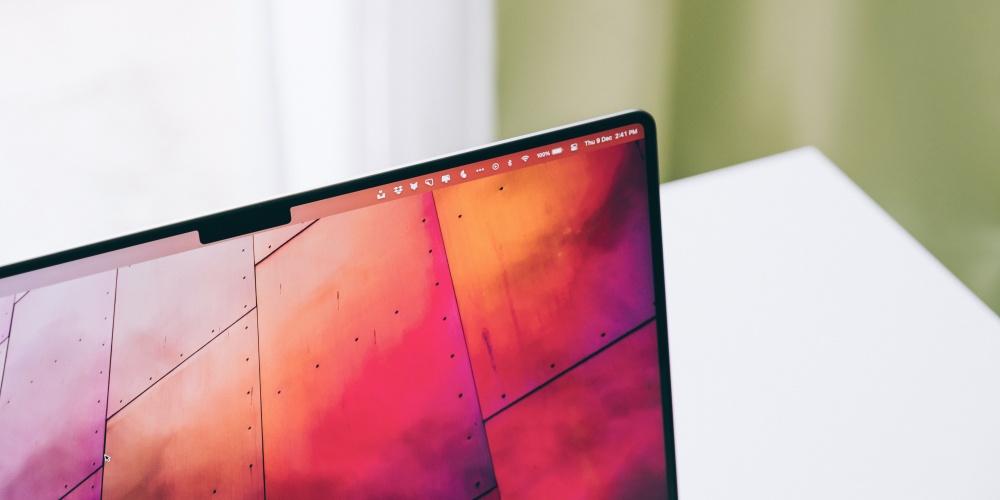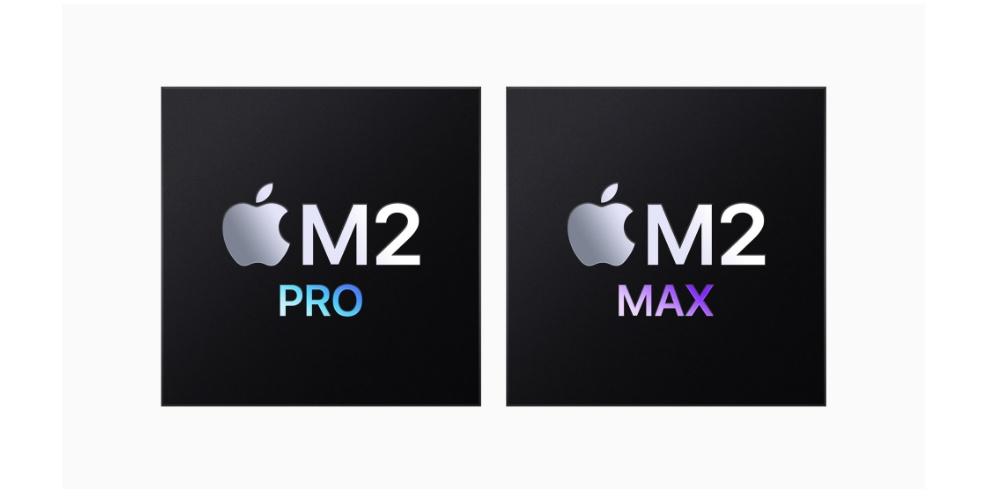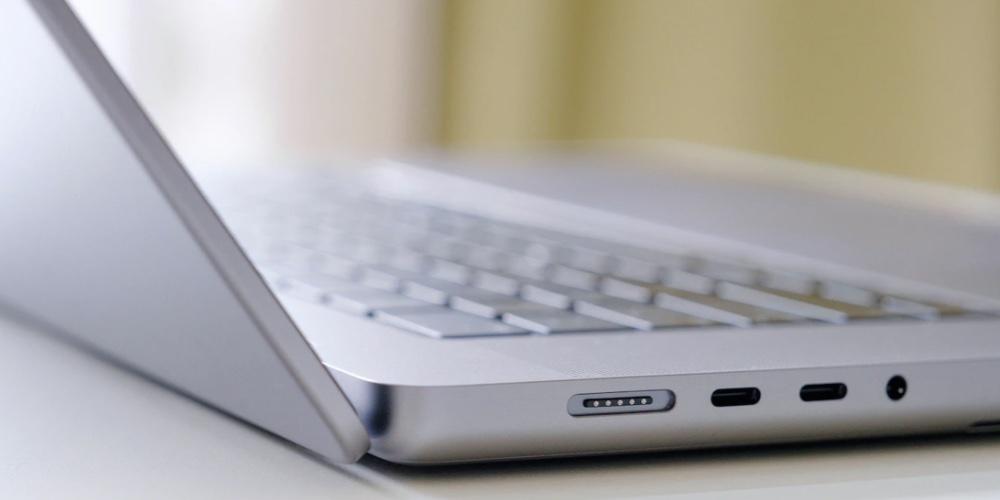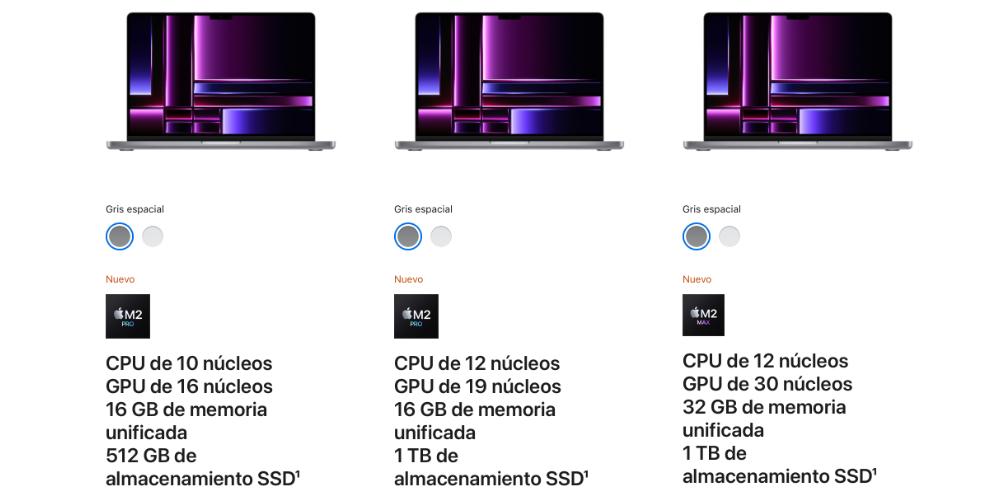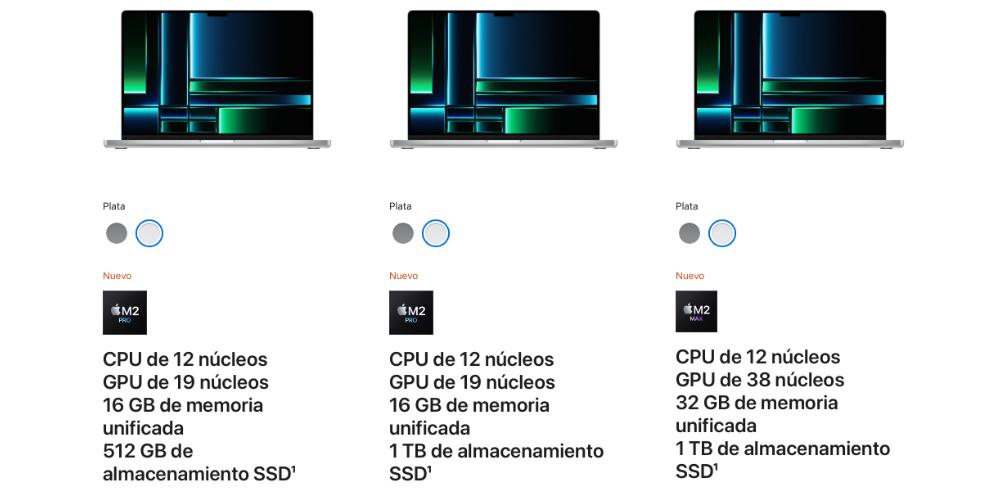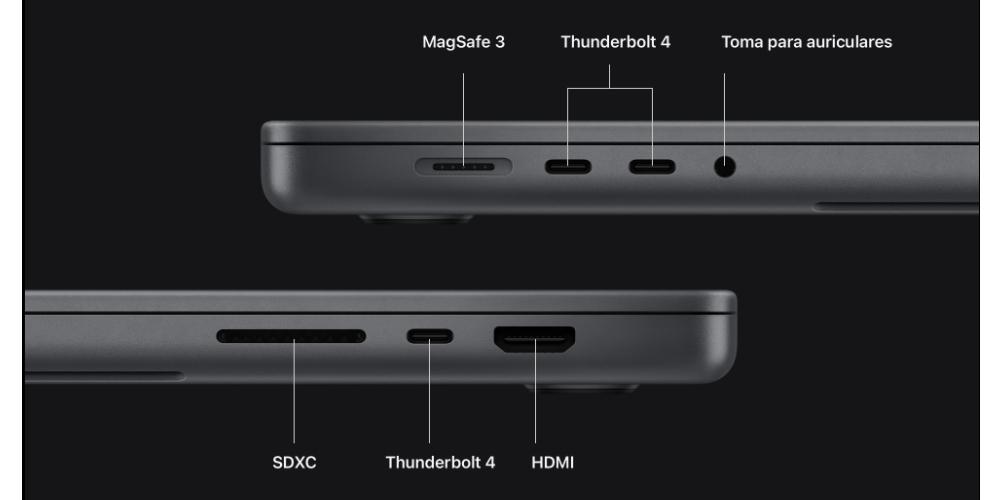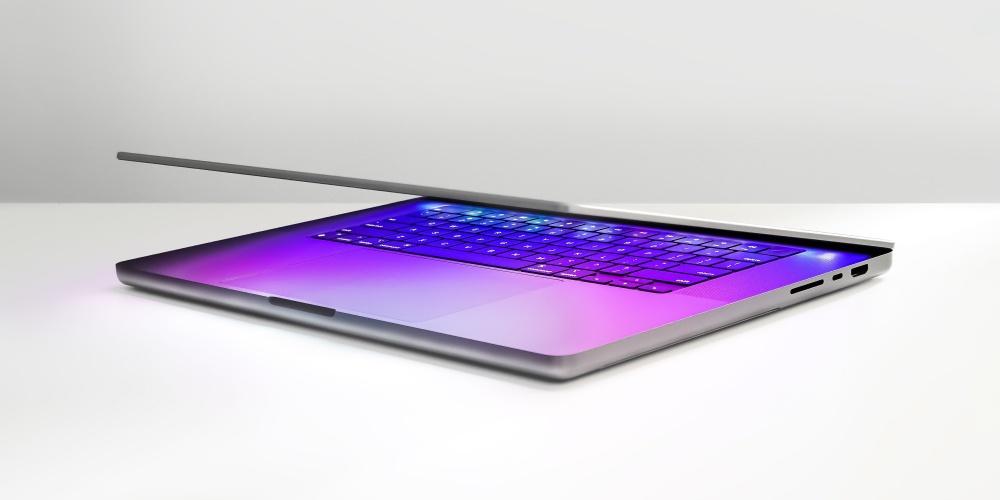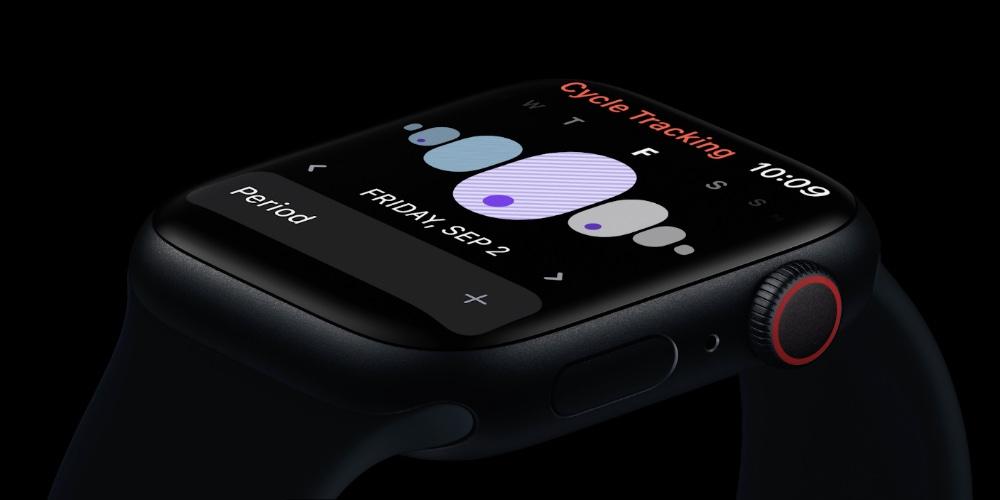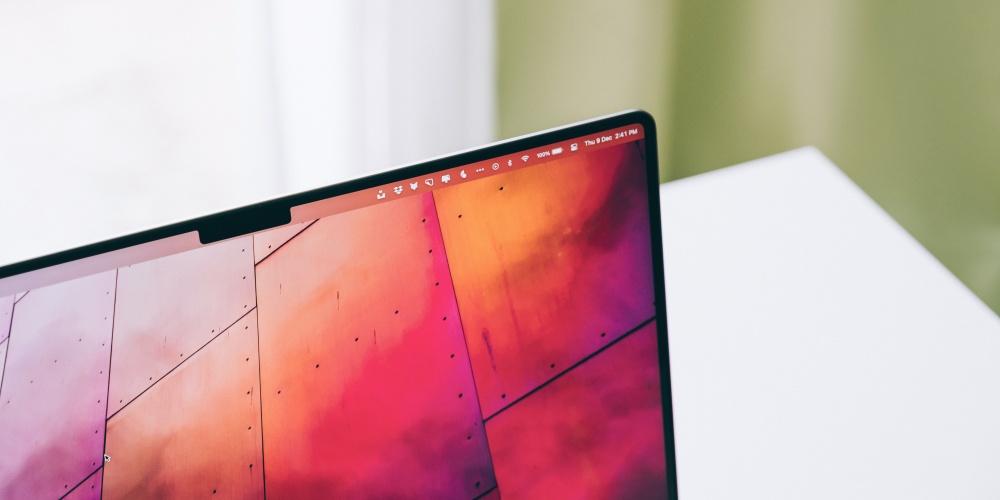
Although the difference in weight is anecdotal, in view of its day-to-day use, it is curious to see how the chip change increases the weight (even in grams). But the difference between the processors does not stop at the weight. But, although the processors are the same, that is not exactly the case. We will see later what is the difference between the M2 Pro and M2 Max processors in both MacBook models.
most important features
In the following sections we will see in detail everything related to the characteristics of the screen, the processors, the battery and the different configurations with which we can find both sizes of the MacBook Pro.
Screen
The screens of these computers are one of their strongest points. In both models the characteristics are almost identical, except for two details. The size and resolution. So, we have two sizes with two different resolutions:
- 14” model: 14.2 inches. 14″ diagonally and 3024 x 1964 resolution. 254 dpi.
- 16” model: 16.2 inches. 16.5″ diagonally and 3456 x 2234 resolution. 254 dpi.
These data that you have seen are the only differences that they present. Both screens have the same image system and share all these elements:
- XDR retina display
- Contrast 1,000,000:1
- 000 nits of brightness (XDR)
- Peak brightness up to 1,600 nits (in HDR)
- 500 nits of brightness in SDR
- ProMotion with adaptive frequency up to 120 Hz
- Fixed refresh rates: 47.95 Hz, 48 Hz, 50 Hz, 59.94 Hz and 60 Hz
M2 Pro and M2 Max chips
Unlike other years, for the MacBook Pro range we do not have the M2 chips available that we can find in the Mac mini or MacBook Air. In this case, both computers have Apple Silicon processors, and for the two screen sizes, we have the following options:
- Up to five configurable options on the 14” MacBook Pro: three variations of the M2 Pro and two with the M2 Max Chip.
- Up to three configurable options on the 16” MacBook Pro: one with M2 Pro and two with M2 Max.
However, these processors are slightly more powerful in the 16-inch MacBook Pro, especially considering the configurations of the base models. The chip Base configuration M2 Pro has these differences:
- 10-core CPU on the 14” model, and 12-core on the 16” model.
- 16-core GPU on the 14″ model, and 19-core GPU on the 16″ model
Regarding the intermediate configuration of the M2 Pro Chip, it presents the same characteristics in the two models. But if we look at the last step, the M2 Max Chip also presents slight differences. And it is that the GPU of the M2 Max, in the 14-inch MacBook Pro is 30 cores, while, on the 16-inch model, it’s 38 cores.
Although they do not seem important differences at first glance, these two computers are designed for a professional public that needs the maximum possible performance. So if you want to have the maximum benefits, not only in terms of screen, it is important that you know this difference in processors between both models.
Battery
The battery life of these devices is very long. This is possible thanks to the fact that we have processors that are very energy efficient, how macOS manages the resources of the computer and also, to very large battery capacities. Therefore, the autonomy of these computers we have:
- 18 hours video playback (14” model)
- 12 hours web browsing (14” model)
- 22 hours video playback (16” model)
- 15 hours web browsing (16” model)
possible configurations
The 14-inch and 16-inch MacBook Pros are built to work with performance-hungry applications and space-hungry files. If we want to be sure that we are going to have the best performance, these are the main features in both base models. For the 14-inch MacBook Pro:
- M2 Pro chip
- 10 core CPU
- 16 core GPU
- 16GB unified memory
- 512GB of SSD storage
Similarly, the 16-inch MacBook Pro has the following base configuration, where we’re going to find all of this:
- M2 Pro chip
- 12 core CPU
- 19 core GPU
- 16GB unified memory
- 512GB of SSD storage
It must be borne in mind that if we are working with RAW photo editing or on many video editing projects, or if we have many apps installed, the base 512GB may not be the best option.
That’s why, if you’re looking for higher performance and capabilities, you can expand certain features on each variant of processors you’ve chosen. But not everything goes with everything, so if you want to boost things like unified memory (which would be RAM) you have to take into account the following:
- In the 14” MacBook Pro we have the following chips, which support the following amounts of unified memory:
- Apple M2 Pro chip with 10-core CPU, 16-core GPU, and 16-core Neural Engine. With this version we can configure the MacBook with 16GB and 32GB of unified memory.
- Apple M2 Pro chip with 12-core CPU, 19-core GPU, and 16-core Neural Engine. Again, with 16GB and 32GB of unified memory.
- Apple M2 Max chip with 12-core CPU, 30-core GPU, and 16-core Neural Engine. Here we have 32GB and 64GB of unified memory.
- Apple’s M2 Max chip with 12-core CPU, 38-core GPU, and 16-core Neural Engine. Here we have 32GB, 64GB and 96GB of unified memory.
- In the 16” MacBook Pro the unified memory configuration is as follows:
- Apple M2 Pro chip with 12-core CPU, 19-core GPU, and 16-core Neural Engine. Here we can configure with 16GB and 32GB of unified memory.
- Apple M2 Max chip with 12-core CPU, 30-core GPU, and 16-core Neural Engine. Here we can configure with 32GB and 64GB of unified memory.
- Apple M2 Max chip with 12-core CPU, 38-core GPU, and 16-core Neural Engine. Here we can select 32GB, 64GB and 96GB of unified memory.
Although the amount of unified memory is scalable depending on the model of the M2 chip, the storage space is already different and gives us more freedom. In both the 14″ and 16″ models, we have two base memory capacities: 512GB and 1TB. Regardless of the processor and unified memory, the following capacities are available: 512GB, 1TB, 2TB, 4TB and 8TB of hard drive space. Only the 512GB capacity is available on the most basic of the 14” and 16” models. The rest of the configurations already start from 1TB.
Other important aspects
In the following sections we are going to see the way in which they can be charged, the ports that we are going to have and we will talk about the resolution of the camera and the speaker system.
ports
If there’s one thing these two new MacBook Pro models have, it’s ports. Gone is the compulsory purchase of adapters and USB-C Hubs to connect peripherals that are necessary if we are in a professional sector. Being able to connect SD cards, external memories or plug our computer into a monitor is something that has changed in this new generation, since Apple has made it easier for us. We have gone from having two (or four) USB-C ports, to having all this in both sizes:
- loading port MagSafe 3
- Three USB-C ports with technology Thunderbolt 4
- slot for SD cards
- Port HDMI
- headphone jack 3.5mm jack
Way to load them
These new MacBook Pros, by incorporating more ports, are not only giving advantages to users to connect peripherals. But also, they make it possible for us to load them in more than one way. MacBook Pros from 2016 to 2021 could only be charged via USB Type C. And MacBooks up to 2015 incorporated MagSafe as the only charging system.
Well, these MacBook Pro models can be loaded to via MagSafe 3 and via USB C. Together with the computer we will get a charging adapter and the USB C to MagSafe 3 cable. This adapter is 140W of power in the 16” model. But for the 14″ model, depending on the processor, Apple includes different powers of adapters:
- M2 Pro with 10 core CPU: 67W
- M2 Pro with 12-core CPU and M2 Max: 96W
camera and speakers
The camera and speakers of these MacBook pro are going to look and sound great. For its part, the FaceTime HD camera has 1080p resolution. Regardless of size and processor, all MacBook Pros have this camera. As for the sound, in both models, we have a system of six high-fidelity speakers, with force cancellation in the woofers and wide stereo sound. And as strange as it may sound, a MacBook with this sound system on its own can fill a room.
Prices
Next, we show you the official price list where you can find the default configurations of these computers. Each configuration can be modified by upgrading processor, cores, unified memory and SSD memory:
- MacBook Pro 14” with M2 Pro: 10-core CPU, 16-core GPU, 16GB unified memory, and 512GB SSD storage: 2449 euro.
- MacBook Pro 14” with M2 Pro: 12-core CPU, 19-core GPU, 16GB unified memory, and 1TB SSD storage: 3049 euro.
- MacBook Pro 14” with M2 Max: 12-core CPU, 30-core GPU, 32GB unified memory, and 1TB SSD storage: 3749 euro.
- MacBook Pro 16” with M2 Pro: 12-core CPU, 19-core GPU, 16GB unified memory, and 512GB SSD storage: 3049 euro
- MacBook Pro 16” with M2 Pro: 12-core CPU, 19-core GPU, 16GB unified memory, and 1TB SSD storage: 3279 euro
- MacBook Pro 16” with M2 Max: 12-core CPU, 38-core GPU, 32GB unified memory, 1TB SSD storage: 4199 euro
Are they worth it?
As you have seen so far, these two computers are two very complete teams, with a large number of features that we can shape to our liking and adapt to our needs. But if you plan to buy a MacBook Pro, we recommend that you buy it with, at least 1TB SSD. As we are dealing with computers on which we are going to install many applications and we are going to work with large files, in the long run 512GB may be somewhat short. But here it is already a matter of weighing what is best for you and what will best suit your work style. If you’re going to get the most out of them, the new MacBook Pros are totally worth it. Especially these two models, as Apple has gone through some accountability and brought back many of the features that professionals really need.
